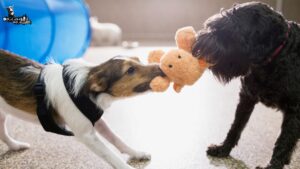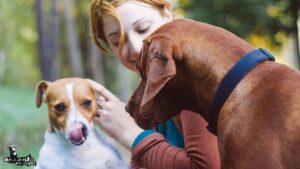It is a general consensus that dogs are highly loyal animals that are very affectionate and forms strong bonds with their owners. Although these strong connections in some cases can create jealous behavior in dogs. Very much like humans, dogs can also feel possessive of their owners, toys, and their place thus making them the targets of jealousy. Being aware of the sources of jealousy and how to manage it, can prevent any difficulty or problem thus giving a peaceful home to your pets and you.
Understanding the Reasons Behind the Emotion of Jealousy in Dogs
Dog jealousy is mainly motivated by a territorial nature they possess as well as the affection they require. If a dog perceives a kind of competition involving any other members of the family, it will react by displaying signs of jealousy. This could be the possession of a new pet, the arrival of a new family member, or the owner’s attitude to someone else.
Some of the things that can make a dog become jealous are:
- The appearance of a new pet or a family member in the household
- Unequal attention
- Preference in treats or playtime
- Interacting with other animals outside the home
- The dog’s routine being changed
If you can see these triggers, you’re one step closer to resolving your dog’s jealousy issues and keeping them in good spirits.

Recognizing That Your Dog is Jealous
Jealousy in dogs, just like in humans, is easily recognizable from the changes in behavior of the pet. Here are the symptoms of your dog’s jealousy that are most common:
- Interrupting Behavior – A dog may push or squeeze his body between you and another pet or person.
- Ill-mannered Behavior – Your dog may growl, bark, or snap at the stranger that is becoming an obstacle of your personal space.
- Angry Actions – Chewing furniture, rip up toys, or knock over things on the floor.
- Undue Attention – At you non-stop, using their paws, crying, or maybe jumping.
- Soil-territory – A ill-bred dog may even pee on the floors to show the territory.
- Loneliness or the Condition of the Dog – The dog can hide, not interact, or even seem upset after the arrival of a new pet or person.
Recognizing these signs will allow you to judge if your dog’s behavior is a result of jealousy or it is due to another reason such as anxiety or a health problem.
Introducing a New Dog to Your Home
One of the biggest jealousy triggers is bringing a new dog into your home. Dogs are creatures of habit, and a new pet disrupts their routine and perceived status in the family. To ease the transition, follow these steps:
- Gradual Introduction – The current dog should be given time to accept the new dog by meeting in the outside world first.
- Give Equal Love – The best way to treat new members of the family is to distribute your love and care equally without any favoritism.
- Personal Space – The dogs will fight less if every dog has its own space – eating, sleeping, and playing area.
- Use of Treats – Use a combination of praise and food to encourage the new pet’s sweet and calm nature.
- Supervised Interaction – The purpose of controlling their communication is to avoid fights and to establish a harmonious relationship.
These actions will lessen the signs of jealousy and foster better relations among the pups.

How to Introduce A New Puppy to A Jealous Dog
When your older pet is displaying signs of jealousy towards a new puppy, you have to be especially careful. The introduction of a new puppy to a jealous dog should be done calmly and conscientiously.
- Initial Meetings on Neutral Ground – The best idea to avoid conflicts for the territory is to meet somewhere else, away from home.
- Gradual Exposure – Begin by spending time with each other for shorter time periods and then take it forward day by day.
- Use of Barriers – Safety and visual acquaintances without confrontation can be ensured through the use of baby gates.
- Separate Resources – Each of them has its belongings to prevent the conflict of food or toys among pets.
- Consistent Training – Offer treats and praise to further encourage good behavior while punishing unwelcome actions.
An introduction that is slow and under control stops the dogs from showing aggressive behaviors and eases the adjustment of both of them.
How to Make Use of and Lessen Jealousy
There are certain techniques to keep the jealousy at bay if it has already emerged:
- Train Your Dog – Teach the dog some basic orders like sit, stay, and leave it, and the dog will obey you.
- Enhance The Relationship – Spend quality time together attending activities such as walks and playing.
- Avoid Punishment – When a puppy does something inappropriate, try being as calm as possible and introduce a different activity that will attract his attention.
- Facilitate Interaction – Constant dog-to-dog meetings can make a dog to be less possessive.
- Look for a Professional Trainer or Behaviorist – Extremely, a dog should be evaluated and treated under the guidance of a specialist before conditions become worst.
The above tactics can lay the foundations for a happy, secure, and confident pet that does not feel a necessity to act in response.

Conclusion
Jealousy in dogs is an inborn instinct but it need not go beyond your control with your involvement and understanding. Knowing the signs of jealousy in your dog and using the method of introducing a new dog into your home slowly and smoothly plus doing the introduction of a new puppy to a jealous dog task correctly are the steps that can help you to build a balanced and a peaceful atmosphere within your home. By giving equal attention, rewarding good behavior, and conducting the training, you can assist your pet animals to live together without creating conflicts triggered by jealousy.
